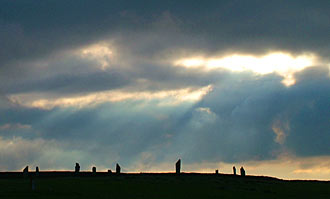
There are at least 50 brochs in Orkney and, alas, I can't exactly remember which one this is. My best, and likely correct, guess is the Broch of Gurness.
In any event, a broch is a fort. There is some question about who was being defended against. Some said the Romans, but that theory has been debunked by other scholars who say they were built as a result of more localized feuding over scarce land or perhaps just as immense status symbols.
Most were built between 600 BC and 100 AD; they were conical in shape and could be as high as five to 13 metres. Since no masonry was used, just dry stone, their builders had a high degree of engineering skill.
The Broch of Gurness, thought to have been erected between 200 BC and 100 BC, was discovered by accident in 1929 by an artist sketching the scenery, when the leg of his stool sank through the turf towards the chamber below.

There are several dry ditches and ramparts around the broch.

Living quarters were built outside the tower and were also enclosed by the ditch:
Scholars estimate about 40 families lived there.
Upright stones marked the divisions between rooms:
Each house contained a hearth, stone furniture, cupboards, and apparently a toilet of sorts - likely not the Thomas Crapper variety, however!
 |
| No, not this! (found on Pinterest) |
Flat stones were used as flagstones and raised as walls and partitions:

A ready supply of flat stones for the partitions lay at the nearby shoreline.

However, erosion is taking its toll here as at other coastal sites:

There appears to have been a rather formal path to the broch:
Over the years, the settlement fell into disuse and was likely partially dismantled over time by other inhabitants of the area looking to use the stones. The houses may have been used by the Picts several centuries later about 500 AD, and still later by the Vikings as a burial mound. Artifacts from both those peoples have been discovered there. Then, after gradually being covered in soil, the site lay undisturbed for a thousand years.
My source for much of this information: http://www.orkneyjar.com/history/brochs/gurness/index.htm
***
 |
| Source http://www.orkneyjar.com/history/standingstones/stennesscentre.htm |
As the sign notes, we followed the temporary path:

Carrie, our See Orkney tour guide, explained the details of the work going on:
It was rainy, so we avoided the muddy pathways. Greg is making his way across the turf:

Nevertheless, the sheer size of the stones was impressive and since the area around them is thought to have been a marshy fen at the time they were erected, the effort expended to transport and raise them is mind-boggling:
I wonder if there was heather 3,000 years ago!

Unlike the Standing Stones of Stenness, which in 1814 a tenant farmer began to knock over when he got tired of ploughing around them, the stones in this ring seem to have toppled for other reasons:
The sign explains how lightning cracked one of the stones:
Incidentally the insensitive farmer was prevented from destroying any more of the Stenness stones and narrowly escaped having his house burnt down by his angry neighbours.
In 1906, the two henges (and other pre-historic sites) were taken into care by the government, the sites protected and studied and many fallen stones restored to their sockets.
(My source for much of this information: http://www.orkneyjar.com/history/index.html)







































